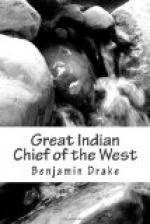APPENDIX.
SKETCHES OF THE SIOUX.
The Sioux or Dacotas, are a numerous, powerful and warlike nation of Indians, who have been appropriately called the Arabs of the west. Between them and the Sacs and Foxes, there has existed, from the settlement of the two latter tribes on the waters of the Mississippi, a hostility of feeling that has kept them embroiled in a constant warfare. The efforts of government to break down their prejudices and make peace between them, have failed in accomplishing that benevolent end. It is not, however, against the Sacs and Foxes alone, that their arms are turned. From time immemorial they have been at war with the Chippeways, and are also constantly making hostile incursions upon other neighboring tribes. They usually fight on horseback, and being very superior horsemen, they are generally more than a match for their antagonists. In Schoolcraft’s Narrative, we find the following account of their numbers, habits and peculiarities of character.
“The numerical strength of the Sioux nation was stated by the late General Pike at 21,675, three thousand eight hundred of whom are warriors. This is the most powerful Indian tribe in North America. It consists of seven bands, namely the Minokantongs, the Yengetongs, the Sissitongs, the Wahpetongs, the Titongs, the Mendewacantongs and the Washpecontongs. These are independent bands under their own chiefs, but united in a confederacy for the protection of their territories; and send deputies to a general council of the chiefs and warriors, whenever the concerns of their nation require it. If one of the tribes is attacked, the others are expected to assist in the repulsion of the enemy. They inhabit all the country, between the Mississippi and Missouri rivers, from north latitude about 46 deg. to the junction of these rivers near St. Louis, with trifling exceptions in favor of some scattered bands of Foxes, Sacs and Kickapoos. Their country also extends south of the Missouri, where the principal part of the Titongs reside, and east of the Mississippi to the territories of the Chippeways—the Winnebagoes and the Menominies. The greatest chief of the nation at present (1820) is Talangamane, or the Red Wing.
“The Minocantongs, or people of the waters, are located at St. Peters, and along the banks of the Mississippi towards Prairie du Chien. They reside in four principal villages.




